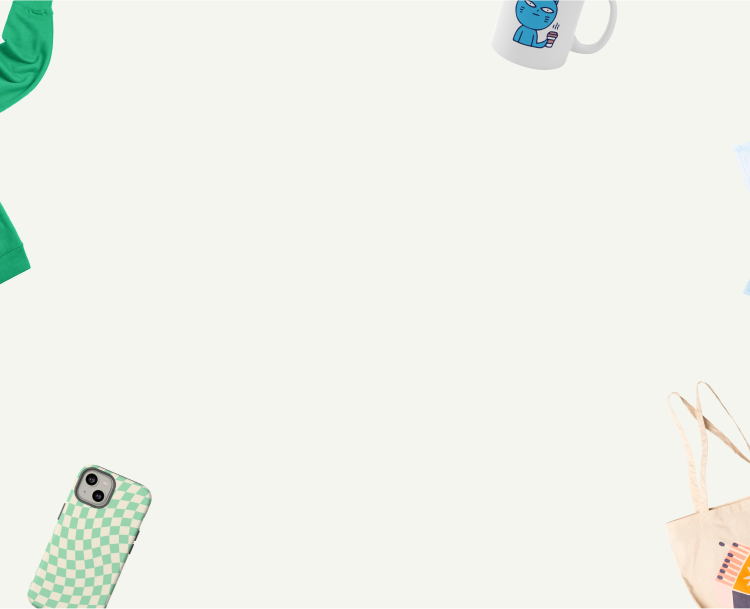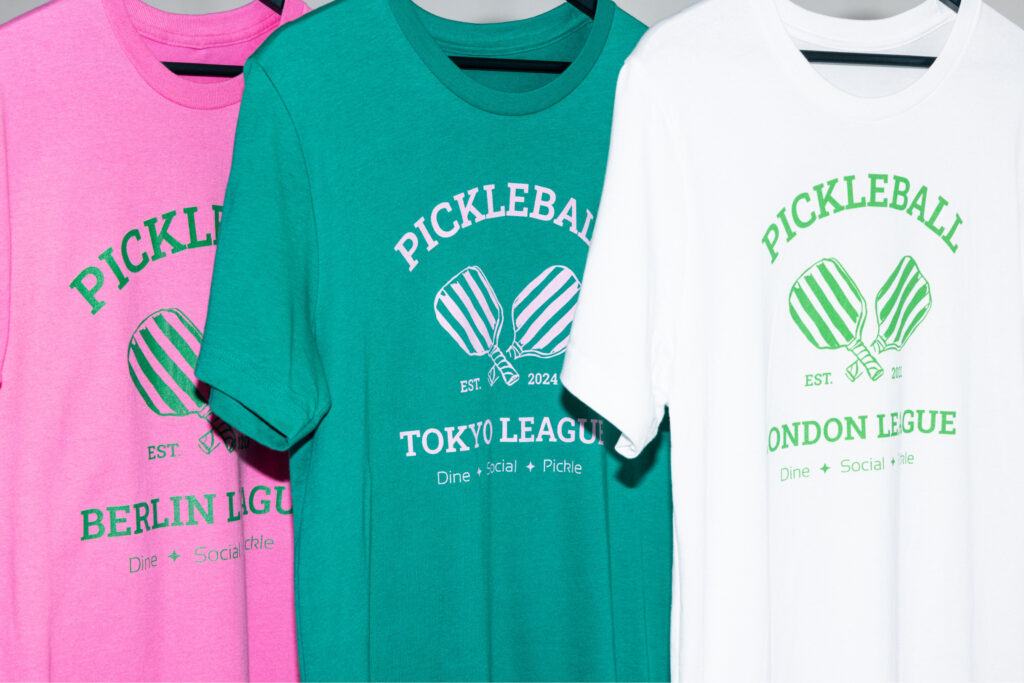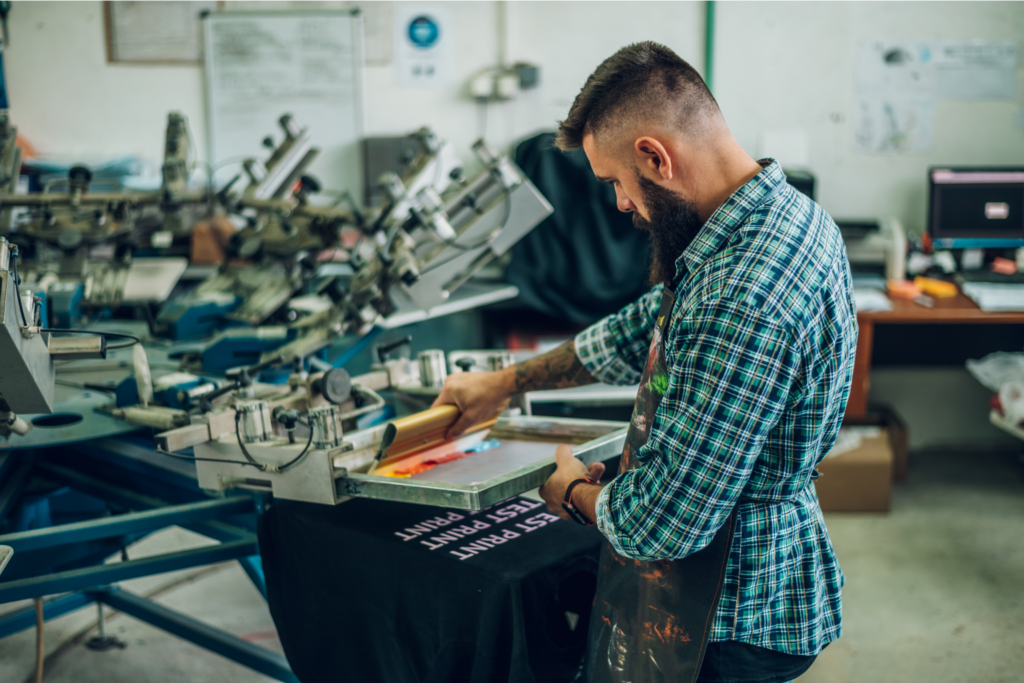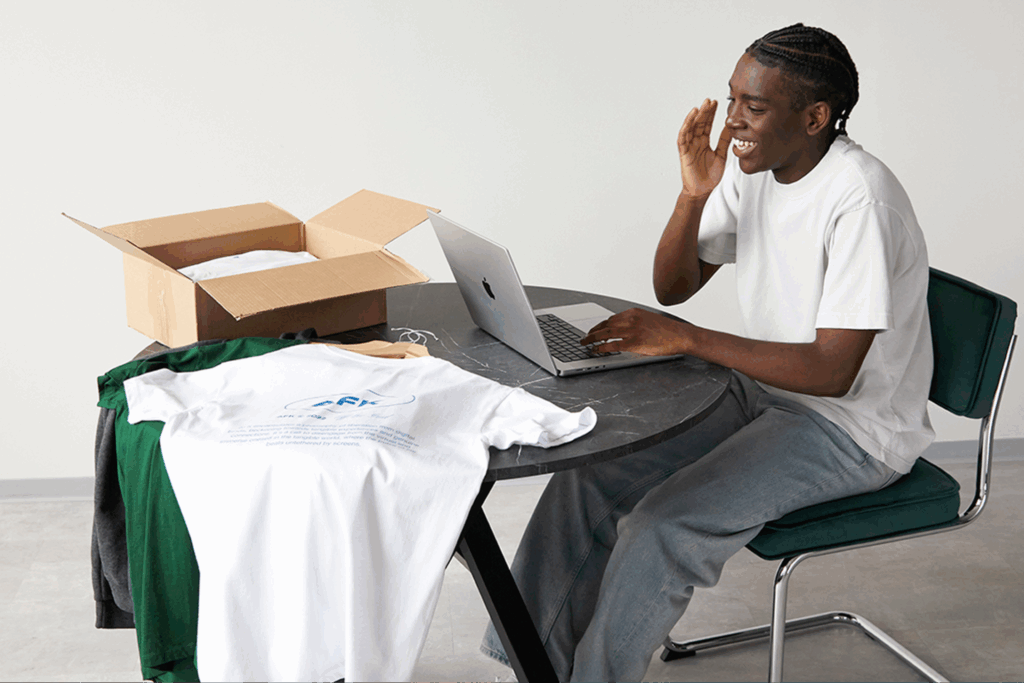Start a custom printing business with Printify
Over the past two decades, Print on Demand (POD) has quietly evolved from a niche experiment into a global industry, offering aspiring entrepreneurs a clear path to achieving global reach. This revolutionary business model allows anyone to start an online business with low startup costs and no inventory, transforming how we think about commerce.
The next five to ten years, however, are poised to be the most critical period of transformation for the print-on-demand industry.
Rapid POD technology innovations are making production faster and more versatile. Evolving consumer preferences are elevating the importance of personalization and sustainability from options to expectations.
New, more dynamic business models are emerging, driven by social commerce and B2B needs. Meanwhile, competition is intensifying and maturing through consolidation, creating immense opportunities and new challenges.
This article offers insight into the future of the print-on-demand market, exploring the trends and technologies shaping the next era of custom commerce.
Key takeaways
The next decade of POD
- A decade of explosive growth: The print-on-demand market is on track to grow tenfold – from roughly $10 billion in 2024 to over $100 billion by 2034 – transforming it from a niche segment into a central pillar of global eCommerce.
- The new consumer standard: Personalization is no longer a feature – it’s the default expectation. At the same time, sustainability is shifting from a buzzword to a requirement, driven by consumer demand and landmark EU regulations like the Digital Product Passport.
- The smart supply chain: Advanced printing technologies like DTG and DTF, combined with automated microfactories, are making production faster and more local. AI now powers generative design tools for creators and intelligent order routing for global fulfillment.
- The storefront is evolving: The point of sale is moving directly into social platforms like TikTok Shop. The most resilient business models will be creator-driven microbrands, subscription clubs, and professionalized B2B merchandise programs that generate recurring revenue.
- Consolidation creates giants and niches: The industry is consolidating toward a potential “Big Three” global networks – exemplified by the Printful-Printify merger. This won’t eliminate competition; it will fuel the rise of specialist providers that win by going deep into specific products, regions, or creator communities.
1. Market trends and forecasts

The global print-on-demand market is no longer a footnote in eCommerce – it’s one of the industry’s fastest-growing segments.
Analyst projections point to a decade of extraordinary expansion, with a compound annual growth rate (CAGR) of 26% through 2034. This remarkable print-on-demand market growth is fueled by several powerful macro drivers that are creating immense global demand.
Regional outlook:
- North America continues to lead in revenue, supported by mature online shopping habits and a vibrant creator economy. The US market alone is expected to grow from $2.53 billion in 2024 to nearly $27 billion by 2034.
- Asia-Pacific (APAC) is the engine of future growth. Rising disposable incomes and rapid mobile adoption are fueling a projected 28% CAGR in the region’s print-on-demand market from 2025 to 2034.
- Europe shows steady growth, but its primary influence will be regulatory. New sustainability rules will shape how print-on-demand services produce and label goods across the EU.
Why demand is rising
Several macro forces are pushing the POD market forward:
- Two key factors are the creator economy and low entry barriers. A single online store can reach buyers worldwide with minimal upfront investment.
- Latest POD trends favor long-tail catalogs. Niche markets thrive because there’s no need for traditional manufacturing runs.
- The business model reduces risk. Products are made only after an order is placed, resulting in fewer stockouts and far less unsold inventory. It’s a low-startup-cost, low-risk business model by design.
- Sustainability matters. Made-to-order production aligns supply with real demand and supports the eco-friendly options that modern shoppers seek.
- Personalization is now expected everywhere. (We’ll dig into customer preferences and loyalty impacts in the next sections.)
Looking toward 2030
By 2030, the POD market is expected to hit $37.85 billion, according to Mordor’s forecasts. Apparel currently leads POD revenue (about 40.93% in 2024), but home decor is growing particularly rapidly, projected to expand at approximately 27.29% CAGR within the POD space through 2030.
In the US, the home decor segment is especially bullish – Grand View Research estimates a 26% CAGR for POD home decor.
These forecasts indicate a product shift: apparel print-on-demand remains foundational, but adjacent verticals like decor, accessories, and lifestyle goods are becoming major growth drivers. These insights highlight a clear path for diversification.
2. Evolving product categories and consumer behavior

Print-on-demand products now cover far more than novelty t-shirts. The catalog continues to expand, catering to the diverse tastes and increasing demands of modern consumers. This growth opens the door to niche markets and gives every online store the freedom to test new products without holding inventory.
Expansion beyond apparel
As noted in the market forecast, apparel still leads the market, but rapid growth in home decor signals broader expansion. Custom t-shirts remain a staple, but wall art, pillows, blankets, and other non-clothing products are racing ahead as high-demand categories.
Beyond apparel and home decor, sellers are leaning into a wider variety of product types and color options, including:
- Drinkware and accessories: Mugs, tumblers, and phone cases are popular choices for personalized gifts.
- Pet products: Custom items for pets are in high demand as owners seek unique ways to celebrate their animal companions.
- Footwear and packaging: Custom shoes and branded packaging are becoming more accessible, enabling a more complete brand experience for any POD business.
The frontier of POD product lines
By 2030, analysts expect POD to expand into areas once considered impractical for one-off production:
- 3D-printed goods: Jewelry, decor accents, and components.
- Furniture and larger decor: Produced using local fabrication paired with printed surfaces.
- Custom packaging and eco-friendly products: Where the unboxing experience is part of the appeal.
These trends give POD businesses fresh ways to differentiate themselves and capture higher profit margins through niche products.
Personalization as the new standard
Personalized products are now the default expectation. Research shows that most shoppers want items and experiences made specifically for them, and many are willing to wait or pay a little extra to get them.
In practice, this includes:
- AI-generated designs: Consumers can co-create completely new designs using AI tools directly within an online store, turning their ideas into print-ready artwork.
- Photo and memory-based products: The demand continues to grow for products that immortalize personal memories, like photo-printed wall art and blankets.
- Name/text customization: This remains a staple across various custom products, from t-shirts to tote bags.
3. The technology revolutionizing fulfillment

The explosive growth projections for Print on Demand are driven by rapid technological innovation. The hardware and software powering POD are becoming faster, cleaner, and smarter – improving low profit margins and enabling new product offerings.
Breakthroughs in core printing methods:
- DTG (Direct-to-Garment): Industrial machines like Kornit’s Apollo can produce up to 400 t-shirts per hour with a single operator, making on-demand printing competitive with screen printing in speed.
The Epson’s SureColor F3070 stacks dual PrecisionCore printheads, a bulk ink system, and automatic thickness adjustment to reduce stoppages and keep production moving. The result: fewer reprints, more predictable shifts, and better labor efficiency.
Innovations also include waterless printing processes and eco-friendly Oeko-Tex certified inks, improving reliability and reducing maintenance. - DTF (Direct-to-Film): Works on cotton, polyester, and blends. The next evolution, powderless DTF, replaces messy adhesive powder with a printed liquid adhesive, making production more efficient and eco-friendly with biodegradable films.
- Sublimation: Known for vibrant, all-over prints on polyester, sublimation is seeing significant growth in apparel and hard goods, like mugs and wall art.
- Embroidery: Digital thread coloring technology from companies like Coloreel dyes a single white thread on the fly, eliminating time-consuming thread changes. This unlocks complex gradients and multicolor designs for one-off orders and dramatically reduces water usage by up to 97% compared with conventional thread dyeing.
- UV printing and laser engraving: These technologies expand POD into non-apparel items. UV printers can create textured 3D effects on surfaces like acrylic and wood, while laser engraving offers precise, durable personalization on metal and glass.
Roland’s VersaUV line, for example, shows the leap from flat panels to cylindrical fixtures and print-and-cut combos, unlocking more non-apparel revenue opportunities in gadget covers, signage, awards, and premium giftware – all without altering your core business model.
For more information on customizing engraved metals, wood boards, and jewelry, check our etching and engraving comparison.
Automation, robotics, and AI workflow optimization:
The real breakthrough in POD isn’t a single machine – it’s the intelligent system that connects them.
- Distributed microfactories: Small, highly automated production hubs are being established closer to customers, reducing staffing needs, shipping times, energy use, and carbon emissions.
Vogue Business profiled Rodinia’s near-shore microfactories, which pair water-free digital printing and software-directed cutting. This helps brands shift from a “design-make-sell” model to “design-sell-make,” reducing overproduction by design. - Robotics and AI-driven quality control: Automation now handles everything from loading and unloading printers to robotic packaging. AI-powered cameras perform real-time quality checks, detecting defects before products are shipped.
- AI workflow optimization: Behind the scenes, AI is the quiet multiplier. Smart order routing algorithms select the best fulfillment location based on customer proximity, facility capacity, and stock levels. Meanwhile, predictive maintenance systems monitor equipment performance to prevent downtime – ensuring a smooth shopping experience for end customers.
4. AI and digital transformation

If hardware is the muscle of the print-on-demand industry, AI is its nervous system. Artificial intelligence now touches every part of the value chain – from design and merchandising to operations and customer experience – giving online businesses a powerful competitive edge.
AI-generated designs
By mid-2024, 65% of organizations surveyed were using generative AI regularly. Tools like Printify’s AI image generator make design accessible, allowing sellers to create unique, print-ready artwork from simple text prompts in minutes. This enables rapid testing of new ideas and instant capitalization on emerging trends.
AI-powered personalization
AI is making the online shopping experience deeply personal. Algorithms analyze customer data to provide tailored product recommendations, personalize website layouts, and power AI assistants that guide users through customization. This level of personalization boosts engagement, increases conversions, and builds lasting customer loyalty.
Demand forecasting
AI can analyze social media signals and market trends to predict which designs and products will be in high demand. This helps sellers make smarter decisions and optimize their marketing strategies, including SEO, paid campaigns, and social media promotions.
Operational AI
This is where AI delivers its biggest impact on profit margins. Intelligent order routing systems automatically send orders to the most efficient fulfillment partner, balancing speed, cost, and quality.
Walmart’s operations team, for example, reported eliminating 30 million miles and avoiding 94 million pounds of CO₂ through AI-powered route planning at scale.
AI also drives predictive maintenance and automated quality control, reducing waste and increasing customer satisfaction.
Web3 and Metaverse convergence
The line between physical and digital products is blurring. “Phygital” items – where an NFT acts as a key to unlock exclusive, token-gated merchandise – are creating new forms of scarcity and community.
Brands like Nike and Adidas have used this model to reward loyal fans with limited-edition apparel, a strategy perfectly suited for a print-on-demand business.
Luxury labels are also experimenting with burn-to-redeem mechanics, where an NFT can be exchanged for a unique physical piece – a pattern that aligns naturally with limited, high-intent POD.
5. Sustainability and regulatory outlook

If the last decade made POD popular, the next will test its values. Customers are asking two simple questions before buying a personalized mug or custom t-shirt: How was this made? and What’s the footprint? At the same time, regulators – particularly in Europe – are turning those expectations into law.
Shoppers have signaled they will reward credible “better” products:
A 2024 global study from Simon-Kucher found that a large share of consumers self-identify as sustainability-minded – and are willing to pay a premium for products that prove it.
PwC reported that most shoppers expect brands to actively reduce environmental impact and are more likely to purchase when they do. These attitudes translate into real pricing power when the proof is visible.
For any print-on-demand business, understanding this context is no longer optional. The search for sustainability has become a competitive advantage, as POD is inherently a more sustainable alternative to fast fashion.
By producing an item only after it’s sold, the model directly combats the massive issue of overproduction that plagues traditional retail. It also pairs well with tangible eco-innovations:
Sustainable materials and inks
There is a rising demand for products made from organic cotton, recycled materials, and other eco-friendly options. Print-on-demand platforms like TPOP and Teemill are building their entire business model around a circular economy, offering GOTS-certified organic apparel and take-back programs.
The larger networks have been moving in the same direction. Printful has an eco-friendly collection with items made from at least 70% certified organic or recycled content, while Printify offers an extensive eco-friendly catalog.
This is complemented by greener inks, with many DTG processes now using water-based, vegan, and Oeko-Tex certified inks that dramatically reduce printing’s chemical and water footprint.
Eco-friendly logistics and packaging
A core sustainability advantage of modern POD is its ability to shorten shipping distances – and with it – carbon emissions. Networks like Gelato and Prodigi are designed around this principle, producing goods as close to the end customer as possible.
Similarly, the smart routing algorithms used by platforms like Printify and Gelato automatically send each order to the nearest in-network facility that can fulfill it, shortening shipping distances and preventing stockouts.
These features were designed for speed and reliability, but they have a powerful, quiet impact on sustainability.
This focus extends to eco-friendly packaging. Printful, for example, has made concrete changes to reduce plastic use, switching its apparel category mailers in North America to 90-100% post-consumer-recycled content and shipping posters in triangular kraft boxes instead of tubes with plastic end caps.
What regulators are asking for next
The EU is turning sustainability expectations into law. The European Commission’s Ecodesign for Sustainable Products Regulation (ESPR) introduces the Digital Product Passport (DPP) – a digital record that will travel with textiles and other goods:
- EU Digital Product Passport: Starting as early as 2027, most textile products sold in the EU will require a DPP. This QR code-based digital record will contain detailed data about a product’s entire lifecycle – from material origin and manufacturing to repairability and recycling instructions.
For the fragmented print-on-demand supply chain, this creates a significant data aggregation challenge. Textiles are expected to be among the first categories affected, meaning POD sellers serving EU customers will need traceable material and process data at the SKU level. - Extended Producer Responsibility (EPR): Under EPR, brands that place garments on the EU market must help fund collection and recycling at the product’s end of life.
For online marketplaces and platforms facilitating sales into the EU, they’ll likely be considered the producer, requiring them to manage compliance and pay fees on behalf of sellers. Some EU member states are already implementing EPR rules, and the Commission aims to harmonize them into a single, EU-wide framework to avoid a patchwork of national systems.
Merchants selling apparel into the EU – even via dropshipping – will need to know who counts as the “producer” and how fees are calculated.
6. Emerging business models and eCommerce shifts

The next decade of the print-on-demand market will be shaped as much by distribution as by decoration.
As the POD market grows, new business models that go beyond the traditional B2C storefront are opening fresh avenues for business growth and improving overall profit margins.
Sales will increasingly originate within social platforms, creative tools will link directly to manufacturing networks, recurring revenue models will complement one-off product drops, and B2B demand will professionalize on-demand programs.
Creator commerce moves inside social apps
The storefront is moving directly into social media, which has become a massive sales channel. TikTok Shop alone posted an estimated $33.2 billion GMV in 2024 worldwide, with $9 billion in the US alone, less than 18 months after its US launch.
Shopify’s enterprise outlook for a typical online business in 2025 places US social commerce near $80 billion in 2025, tracking a broader global rise in in-app buying.
The infrastructure is in place: major print-on-demand platforms like Printify, Printful, and Gelato offer direct integrations with the major social platforms, so creator catalogs can be published and fulfilled without leaving the app. That, by itself, is a key driver of the industry trends.
Subscriptions and membership clubs
To build recurring revenue, some brands are launching subscription clubs that offer members exclusive monthly merch drops – from unique t-shirts to accessories.
Limited drops will always drive excitement and engagement, but recurring revenue is becoming the foundation of a resilient POD business model. Across sectors, the Subscription Economy Index reports subscription companies growing 3.4x faster than the S&P 500 over the long term – a signal that flexible, recurring monetization is gaining share in consumer spending.
B2B on-demand scales corporate and event merchandise
Beyond consumer storefronts, B2B demand is both significant and rapidly formalizing. The market for corporate merchandise, team uniforms, and event swag is a massive, largely untapped market for Print on Demand:
The US promotional products sector reached $26.78 billion in 2024, according to PPAI, with distributors leaning into digital expansion and sustainability.
As procurement teams seek faster replenishment and tighter brand control, the POD industry is well positioned to deliver, offering short runs, localized production, and consistent decoration without unsold stock.
Design platforms connect to fulfillment rails
The print-on-demand industry is becoming more interconnected. Design platforms like Canva are integrating directly with fulfillment networks, turning creative tools into manufacturing hubs and making it easier than ever to launch custom-designed products.
As this model matures, the print-on-demand industry will look more like “APIs for manufacturing” than a set of isolated shops. Routing, color management, and compliance data can travel with a design file from canvas to carrier.
Niche microbrands
This shift toward in-app social commerce is the primary engine powering the rise of niche microbrands.
As the global market becomes more crowded, a successful POD business will often be highly focused. By targeting specific niche markets – from fans of a particular video game to owners of a specific dog breed – sellers can build a loyal community and face less direct competition.
7. Competitive landscape and consolidation

The battle for the future of Print on Demand is happening on multiple fronts. Open Etsy, Amazon, or TikTok Shop, and you’ll see thousands of creators, brands, and manufacturers trying to capture the same demand.
At the same time, the industry is undergoing a period of significant consolidation behind the scenes. Fulfillment networks and software platforms are racing to connect design tools, printing technology, and logistics into one seamless system. In other words, the field is getting bigger but also more connected.
Who is building the rails: Key players and their models
The field is dominated by a few key archetypes, with each print-on-demand platform taking a unique approach to capturing the growing demand:
- Hybrid verticals: Printful represents the vertically-integrated powerhouse, historically focusing on its own in-house production facilities. This model gives them tight control over quality and consistency, which they leverage as a premium selling point.
Their challenge is scaling as quickly and broadly as a network model (more on the Printful-Printify merger below).
- Network aggregators: Companies like Printify and Gelato operate as sprawling, asset-light marketplaces. Their competitive edge comes from a massive product catalog sourced from a global network of independent print providers, all orchestrated by sophisticated software that routes orders to optimize for cost and speed.
They compete on range, flexibility, and price.
- Creator marketplaces: Marketplace gravity still matters. Etsy continues to pull in artists and artisans, closing 2024 with about 5.6 million active sellers and 89.6 million active buyers. Similarly, platforms like Redbubble and Teespring focus on the front end, giving creators a direct path to an existing target audience. Their strength is their community, but they face challenges with high fees and oversaturation.
- Captive ecosystems: Amazon Merch on Demand plays a different game. Its power isn’t in its production network but in its unparalleled access to Amazon’s massive customer base and the allure of Prime shipping. For sellers, it offers a built-in audience at the cost of brand autonomy.
- Adapting traditional layers: Legacy companies aren’t standing still. Vistaprint (rebranded as Vista), CustomInk, and Shutterfly are all adapting, acquiring software companies and integrating POD offerings to compete with the new, asset-light generation.
Consolidation that tells a story
The biggest headline in 2024 was the Printful-Printify merger, creating a dominant platform that unifies leadership and fulfillment strategy under one roof while maintaining both brands.
This move is the centerpiece of a long-running trend:
- Redbubble bought TeePublic to deepen its artist marketplace footprint and US reach.
- Kornit Digital acquired Custom Gateway and built KornitX, signaling that software orchestration is as critical as print hardware for on-demand production.
- Shutterfly purchased Spoonflower to expand beyond photos into home decor.
- Vistabrand acquired several creative tools and rebranded as Vista to pull content creation and manufacturing closer together.
The value is shifting toward companies connecting design, audience, and distributed manufacturing in one seamless flow.
The new battlegrounds: How providers compete
As consolidation tightens the market, the basis of competition is shifting from simply existing to excelling in three key areas:
- Catalog range vs curation: While networks compete to offer the largest possible catalog, winning brands will curate tight, high-quality collections rather than offering everything imaginable.
- Product quality and consistency: With similar product offerings across multiple platforms, demonstrable quality is now a key selling point. Reliability, accurate color reproduction, and durable materials are no longer optional – they’re essential to retain customers. In the race to become a top POD store, exceptional customer service also emerges as a major differentiator.
- Measurable eco-positioning: Sustainability is moving from a marketing slogan to a measurable practice. Driven by EU regulations, the ability to provide transparent data on materials, sourcing, and end-of-life options is becoming a powerful competitive advantage.
The end game: A “Big Three” by 2030?
The most likely outcome of this consolidation is the emergence of a “Big Three” global POD networks by the end of the decade.
- The merged Printful/Printify entity is the clear first contender.
- Gelato, with its sophisticated software and asset-light global model, is a strong candidate for the second spot.
- The third could be a marketplace giant like Amazon that fully leverages its logistics and customer base, or a dark horse that successfully consolidates regional players.
This dominance at the top won’t eliminate competition; instead, it will create clear opportunities for a successful POD business to thrive as a niche or specialist provider.
Smaller players will adopt strategies that help them thrive by going deep rather than broad, focusing on specific product categories like high-end art prints or sustainable apparel, excelling in regions like Asia-Pacific or Latin America, or serving specific creator communities with tailored tools and support.
8. Future scenarios and what to watch

The future of Print on Demand is not a single, straight line. As tools improve and buyer behavior shifts, the print-on-demand industry can move in two directions: more local, on-demand production in many cities, and tighter software that links design to fulfillment across borders.
The most realistic outcome is a blend of the two, and that blend is poised to reshape large parts of global commerce.
Radical scenario: On-demand everywhere
Picture designing a gift on your phone at breakfast and getting it from a nearby site the same evening. That “on-demand everywhere” future is a hyper-localized and radically efficient vision that pairs dense local production with POD fulfillment technology, routing each job to the closest capable hub.
Think automated lines, predictive maintenance that keeps presses running, and camera-based quality checks that cut reprints. The payoff is shorter delivery times, lower transport emissions, and less overproduction – a practical path to sustainable POD rather than a slogan.
This future is powered by a seamless technological backbone. AI-driven order routing instantly sends your order to the nearest automated production hub with capacity. Predictive maintenance algorithms ensure these facilities run 24/7 with minimal downtime, while robotic quality control systems inspect every item, guaranteeing perfection.
Middle-ground scenario: Steady growth with integration
A more probable arc is quieter but still powerful. The global POD market keeps expanding as a handful of large platforms stitch design, routing, and compliance into one stack.
The Printful-Printify merger is a signal: software, partner reach, and reliability become the operating system for the print-on-demand business model. Call this the hybrid retail decade, when POD keeps expanding but slots into everyday shopping rather than replacing it.
On the ground, more in-store customization moments appear next to robust online catalogs. Flagship examples like UNIQLO’s UTme! let shoppers create a design in minutes and walk out with a personalized piece, while most made-to-order volume still routes to regional producers behind the scenes via POD fulfillment technology.
By 2030, the print-on-demand market will feel mainstream, but not dominant. Technology adoption is deliberate and doesn’t happen overnight. Enterprises are rolling out AI where it clears bottlenecks in routing, maintenance, and service, but it’s not a flip-the-switch revolution. IBM’s global survey found that about 42% of large companies had actively deployed AI, with another cohort still experimenting.
This scenario is also heavily shaped by the enforcement of Europe’s new rulebook, including the DPP and EPR schemes, which favor platforms with robust data traceability.
Meanwhile, the toolkit continues to improve through proven methods such as DTG, DTF, sublimation, embroidery, and UV printing. The result for shoppers is simple: faster, more consistent output across a wider range of print-on-demand products.
The plausible path: A pillar of modern commerce
The most realistic future isn’t a third, separate path, but a strategic evolution of the middle-ground scenario. It anchors on steady, integrated growth but accelerates it with key innovations that make POD an indispensable pillar of world commerce. This outcome sees the industry mature from a niche alternative into a mainstream powerhouse.
This path is defined by undeniable financial momentum. The market isn’t just expanding; it’s compounding into a core component of eCommerce. Driven by powerful consumer and enterprise demand, it solidifies its place in the tens of billions by 2030.
Personalization becomes a non-negotiable standard, pulling in shoppers, while businesses lean on POD for everything from rapid product pilots to corporate merchandise.
The logistics network becomes radically more efficient, borrowing a key element from the optimistic scenario. Delivery windows shrink as intelligent routing to local production hubs becomes the norm, making five-day global delivery a standard expectation.
This efficiency aligns with sustainability, which evolves from a marketing claim to a measurable practice, enforced by strict EU regulations like the Digital Product Passport.
In this future, POD won’t entirely replace traditional manufacturing. Instead, it becomes an essential, parallel system – the default choice for any product type where speed, customization, and transparency are paramount.
Closing thoughts
The evolution of Print on Demand is no longer just a story about selling custom t-shirts online; it’s a blueprint for the future of manufacturing and retail. The combination of intelligent software, advanced hardware, and shifting consumer values has created a new paradigm – one where the friction between an idea and a physical product is dissolving.
The next decade will redefine what “value” means in commerce. It will be measured not by the scale of production runs, but by the speed of delivery, the depth of personalization, the transparency of the supply chain, and the elimination of waste. This is the core advantage of the on-demand model, and it will drive its integration into every facet of our economy.
Success in this new era depends on using the right tools, which are no longer experimental but sophisticated and interconnected. The demand for unique, responsibly made products isn’t just a trend; it’s the new standard.
For the creators, entrepreneurs, and brands willing to master this new ecosystem, the opportunity is to build a business and the future of commerce itself.












